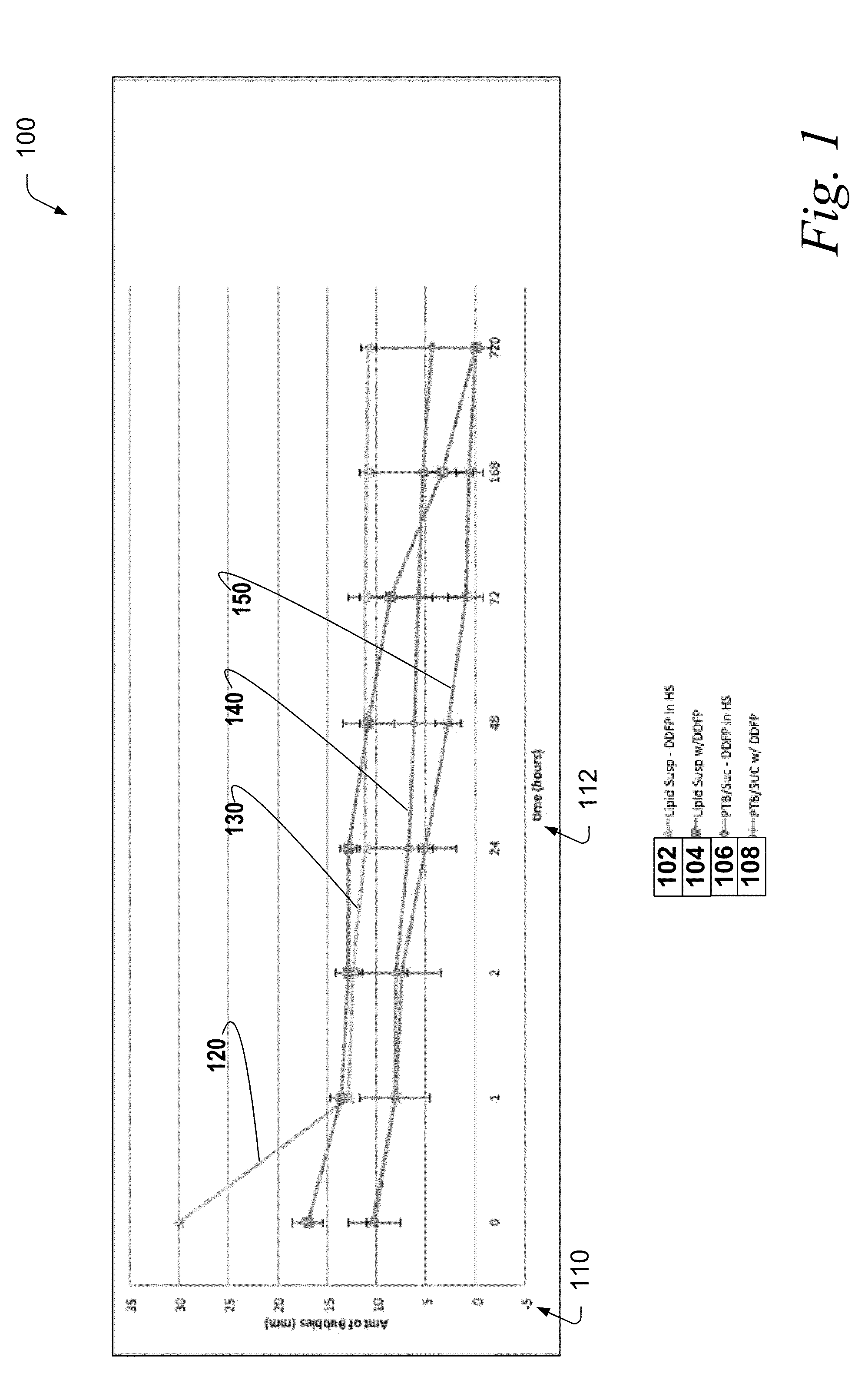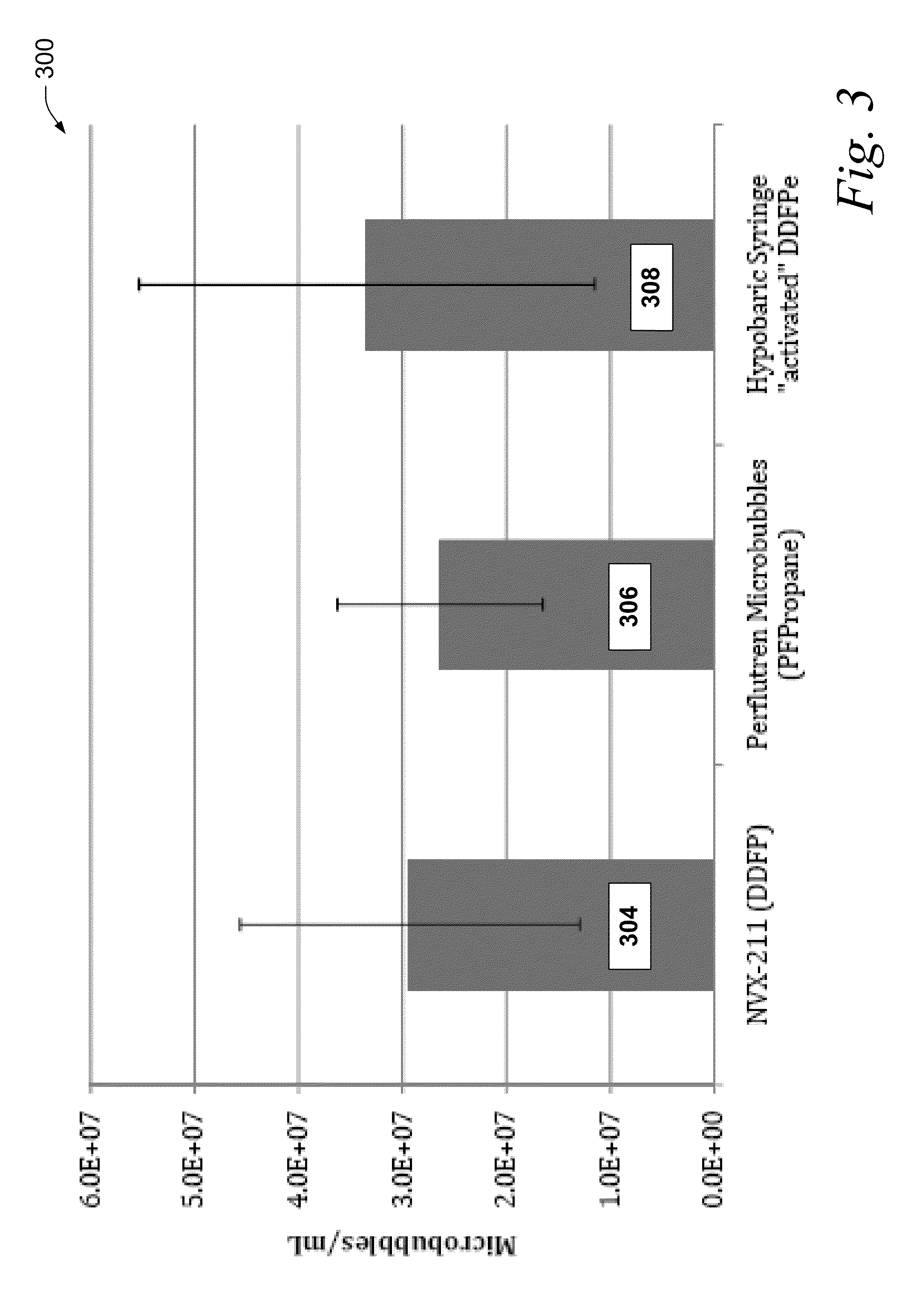Microbubble Compositions, Method of Making Same, and Method Using Same
a technology of compositions and microbubbles, applied in the field of microbubble compositions, can solve the problems of high echogenicity, relatively short useful life of air bubbles, and achieve the effect of long shelf li
- Summary
- Abstract
- Description
- Claims
- Application Information
AI Technical Summary
Benefits of technology
Problems solved by technology
Method used
Image
Examples
example 1
Perfluoropentane Gas Filled Microbubbles with a PTB Shell Formed in an Atmosphere of Perfluoropentane
[0065]The headspace of a 4 mL vial is determined by first filling the vial with water. A septum and cap is added to the vial to displace enough water to allow the vial to be sealed. The septum and cap are then removed. The volume of water remaining in the vial, representing the precise volume of the vial, is then emptied into a graduated cylinder, measured and the amount recorded.
[0066]The headspace volume of the vial is determined by subtracting a desired volume of a stabilizing material from the measured volume of the vial recorded in the previous step. The amount of core gas that would fill the headspace volume when volatilized is then determined using Ideal Gas Law calculations.
[0067]Next, 3 mL of a PTB / sucrose solution, the stabilizing material, is added to the vial. A septum is placed onto the vial, and the vial is capped and crimped. The headspace of the vial is evacuated usin...
example 2
Perfluoropentane Gas Filled Microbubbles with a Lipid Shell Formed in an Atmosphere of Perfluoropentane
[0069]The method in Example 1 is followed, except that 3 mL of a lipid suspension is used as the stabilizing material in place of the PTB / sucrose solution. The lipid suspension comprises 2 mg of an 82 mole % dipalmitoylphosphatidylcholine (“DPPC”), 10 mole % dipalmitoylphosphatidylethanolaminepolyethylene glycol having an average molecular weight of 5,000 daltons (“DPPE-PEG5000”), and 8 mole % dipalmitoylphosphatidic acid (“DPPA”) mixture per 1 ml of a solution of saline / propylene glycol / glycerin solution. The composition of Example 2 comprising DPPC / DPPE-PEG 5000 / DPPA stabilizing material is designated as Composition 120 in FIG. 1.
example 3
Perfluoropentane Gas Filled Microbubbles with a PTB Shell Formed in Solution
[0070]Approximately 30 mL of a PTB / sucrose solution is prepared. The solution is placed in a round bottom flask containing a stir bar. A nitrogen manifold is attached to the flask. Perfluoropentane was added to the flask. The nitrogen manifold is opened to pressurize the flask with nitrogen gas. The flask is placed on a stir plate and stirred for approximately 60 minutes. The contents of the flask are added to a homogenizer and allowed to circulate for 6 cycles, which is determined by the homogenizer flow rate and volume of mixture. The mixture is removed from the homogenizer and filtered through a 0.2 micron sterile filter.
[0071]Approximately 3 mL of the filtered mixture is dispensed into a clean, sterile, nitrogen evacuated 7 mL serum vial. A septum is immediately added to the vial and the vial is capped and crimped. The vial is placed on a mechanical shaker (Bristol-Myers Vialmix) set at about 75 Hz rpm f...
PUM
 Login to View More
Login to View More Abstract
Description
Claims
Application Information
 Login to View More
Login to View More - R&D
- Intellectual Property
- Life Sciences
- Materials
- Tech Scout
- Unparalleled Data Quality
- Higher Quality Content
- 60% Fewer Hallucinations
Browse by: Latest US Patents, China's latest patents, Technical Efficacy Thesaurus, Application Domain, Technology Topic, Popular Technical Reports.
© 2025 PatSnap. All rights reserved.Legal|Privacy policy|Modern Slavery Act Transparency Statement|Sitemap|About US| Contact US: help@patsnap.com



